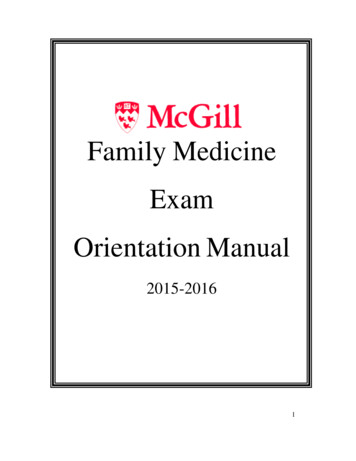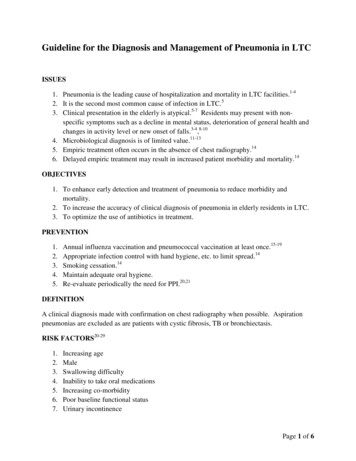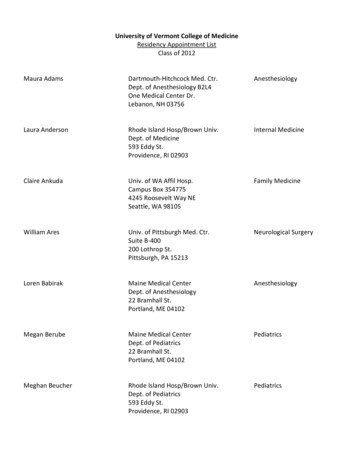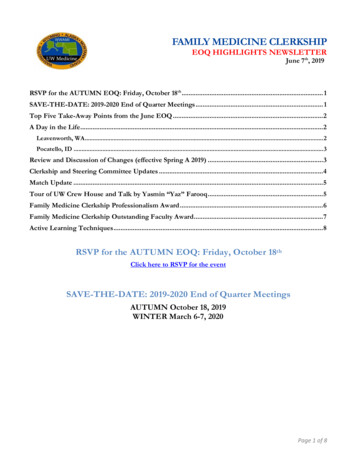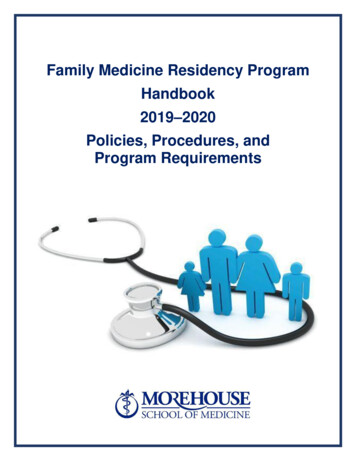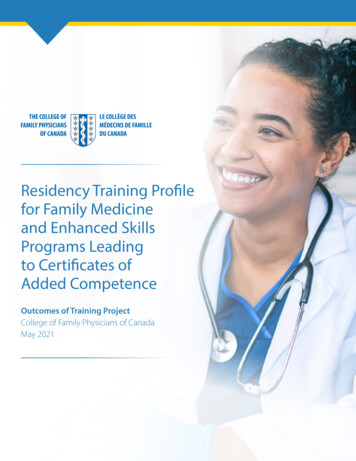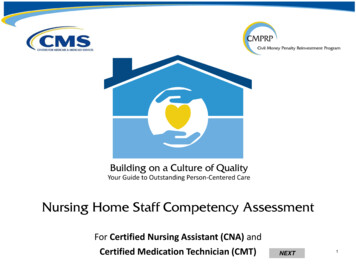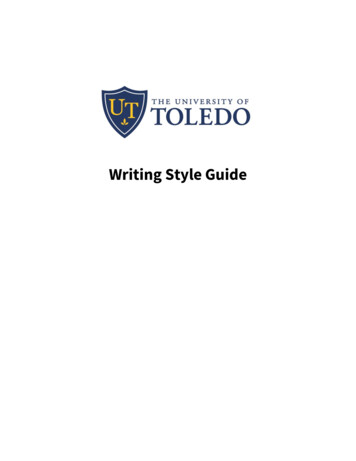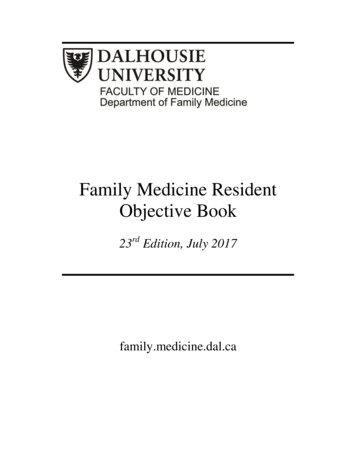
Transcription
Family Medicine ResidentObjective Book23rd Edition, July 2017family.medicine.dal.ca
Table of ContentsPURPOSE4RESPONSIBILITY4PREAMBLE TO THE CURRICULUM DOCUMENT FOR RESIDENTS5THE NEW TRIPLE C COMPETENCY-BASED CURRICULUM6Behavioural Medicine/Mental Health7Care of Adults10Care of Children and Adolescents17Care of the Elderly20Global Health and Care of the Vulnerable and Underserviced25Maternal and Newborn Care28Men’s Health Care32Palliative Care35Procedural and Surgical Skills38Professional Competencies41Women’s Health Care44CURRICULUM DELIVERY47MANDATORY ACADEMIC CURRICULUM TOPICS48PORTFOLIOS49ASSESSMENT, EVALUATION AND FEEDBACK50Field Note Easy to Follow Instructions52Field Note Sample54Characteristics of a good Field Note57Template for In-Training Assessment Process59In-Training Assessment Report (ITAR) for Family Medicine61Bi-Annual Resident Performance Review Worksheet71RESIDENT PROJECT GUIDE85Types of ProjectsWorksheet and Dates for Completion ofResident ProjectGuide on How to Organize Resident Projectsbased on Type of ProjectSample Paper Outline879199112Dalhousie Family Medicine Resident Objective Book 2017-2018Page 3 of 113
PURPOSEThe residency program in Family Medicine at Dalhousie University has undergone revisions to become a1Triple C Competency Based Curriculum .A number of steps have been taken in this process. There has been a complete revision of the program'sCurriculum Objectives. The field notes have been revised and integrated with In Training AssessmentReports (ITARs).This document will introduce these core elements of the program's curriculum. It will also give you informationon: CanMEDS FM; The structure of the Academic Curriculum; Guidelines around the Resident Project.RESPONSIBILITYResident: To review the relevant objectives prior to each clinical learning experience and determine with thesupervisor what can and should be achieved.Supervisor/Preceptor: To review the relevant objectives prior to each clinical learning experience anddetermine with the resident what can and should be achieved.Site and Program: To ensure that each site provides the learning opportunities and structured evaluationstated in this document.1Triple C Comprehensive, Centered in Family Medicine, Continuity of Patient Care, Learning Environment and CurriculumDalhousie Family Medicine Resident Objective Book 2017-2018Page 4 of 113
PREAMBLE TO THE CURRICULUM DOCUMENT FOR RESIDENTSThe delivery of the Dalhousie Family Medicine Residency Program is based on the provision of both strongclinical experiences and a focused academic curriculum. This delivery is grounded in the Four Principles of2Family Medicine and now structured around the CanMEDS FM roles as developed by the CFPC NationalWorking Group on the Postgraduate Curriculum. Please refer to http://www.cfpc.ca to view the CanMEDSFamily Medicine: A Framework of Competencies in Family Medicine. In this framework, the Family MedicineExpert integrates the competencies included in the roles of Communicator, Collaborator, Manager, HealthAdvocate, Scholar and Professional.The CFPC Evaluation Objectives is the other document that has a major influence on the curriculum. Itincorporates the Phases of the Clinical Encounter, the Skill Dimensions, the Priority Topics with their KeyFeatures, and the Themes of Communication and Professionalism with their Observable Behaviours.It is important to differentiate curriculum objectives and assessment objectives. It is the curriculum objectivesthat define the broad knowledge base that is required for residents to gain over the 24 months of the trainingprogram. It is the assessment objectives that form the basis of assessment of competency in a sampling ofthese areas. Thus it is appropriate that the Priority Topics drive our curriculum to a certain extent, but residentsare expected to know more than what is included in the Key Features under each Priority Topic. Key Featuresare considered when planning the objectives of every seminar.Residents are assessed on their participation and presentation in seminars and workshops, as well as in manyother facets of the program. Please see the Bi-Annual Review document for a full list. Much of the assessmentis accomplished in real clinical situations based on the clinical objectives in each clinical learning experience.We focus on assessment for learning as well as assessment of learning. This means that we use allassessment tools to stimulate your learning and to see how you are doing at the same time. Documentation ofthe in training assessment occurs with the use of Field Notes - which provide a narrative of what went well,with suggestions for improvement, with common reflection on multiple encounters from multiple observers.This information is summarized later to help populate the In Training Assessment Reports (ITARs) for eachclinical learning experience. Your preceptor will help you create a personalized learning plan with thecompletion of each Narrative ITAR. This and other information, with some of your reflections, will be usedtwice per year by your Site Director or their designate to complete the Bi-Annual Resident PerformanceReview. A learning plan will also be developed to stimulate your learning and to help you achieve competenceas quickly and efficiently as possible.21) The Family Physician is a skilled clinician2) The Family Physician is community-based3) The Family Physician is a resource to a defined community4) The doctor-patient relationship is central to the role of Family PhysicianDalhousie Family Medicine Resident Objective Book 2017-2018Page 5 of 113
THE TRIPLE C COMPETENCY-BASED CURRICULUMThe Dalhousie Family Medicine academic curriculum was extensively re-organized in 2013. This reflected thenational movement of all post-graduate Family Medicine Residency Programs to adopt the CFPC’s Triple Ccompetency-based curriculum.The curriculum is divided into 11 domains (derived from those established by the CFPC National WorkingGroup on Postgraduate Curriculum Review): Behavioural Medicine and Mental Health CareCare of AdultsCare of Children and AdolescentsCare of the ElderlyGlobal Health and Care of the Vulnerable and UnderservicedMaternal and Newborn CareMen’s Health CarePalliative CareProcedural and Surgical SkillsProfessional CompetenciesWomen’s Health CareWithin each domain the structure (headings and sub-headings) reflects the CanMEDS FM roles (again asdeveloped by the Working Group on the Postgraduate Curriculum). Each sub-heading is written in languagethat emphasizes that it is the program’s responsibility to provide a learning opportunity to the resident toaccomplish the following objectives. The implication, of course, is that it is the residents’ responsibility to availthemselves of the opportunity.At the level of individual objectives, each objective is written in a competency-based manner. That is,completion of a certain clinical learning experience or having a certain clinical experience is no longer the goal.The goal is to achieve the clearly stated desired outcome.In addition, wherever possible, the objective will reference the applicable Priority Topic/Key Feature(developed by the CFPC National Working Group on Certification). This will be indicated by a bracketedreference (e.g. Elderly 2 would obviously reference the second Key Feature in the Priority Topic: Elderly)Dalhousie Family Medicine Resident Objective Book 2017-2018Page 6 of 113
Behavioural Medicine/Mental HealthFamily Medicine 1.9.2.2.1.9.3.2.1.9.4.2.1.9.5.The learning environment will provide opportunities for residents to demonstrate integration of all theCanMEDS-FM roles in order to function effectively as a generalist in the provision of behavioural medicineand mental health care.The learning environment will provide opportunities for residents to establish and maintain clinicalknowledge, skills and attitudes required to meet the needs of patients in the areas of behavioural medicineand mental health.The family medicine resident will recognize and diagnose mental health problems commonly found infamily practice including anxiety disorder (Anxiety 1-5), mood disorders (Depression 1-10),schizophrenia (Schizophrenia 1-8), personality disorders (Personality Disorder 1-5), post-traumaticstress disorder, phobic states, eating disorders (Eating Disorders 1-6), somatization disorders(Somatization 1-4), chronic pain syndromes and addiction (Substance Abuse 1-9). They will be ableto:Demonstrate familiarity with the DSM diagnostic criteria for these common disorders.Demonstrate ability to appropriately screen for these disorders in high-risk groups.Demonstrate ability to assess cognitive status with an appropriate instrument (MMSE or MOCA).Take an appropriate history to generate differential diagnoses for symptoms, which also includesmedical causes and contributors to rule out serious organic pathology.Assess patient's suicide risk, homicide risk and judgment.Identify comorbid psychiatric conditions.Identify the functional impact of the symptoms to help guide and evaluate treatment.The resident will develop a management plan and provide appropriate follow up for these disorders,including the ability to:Offer appropriate treatment in a way that promotes full discussion of options and patient’s owndecision-making.Use a multidisciplinary approach to treatment and management and refer appropriately.Use a multifaceted approach to treatment.Include psychosocial support as part of the treatment plan.Demonstrate knowledge of indications, side effect profile, common interactions and monitoringrequirements of psychopharmacological agents such as antidepressants, antianxiety medications,mood stabilizers, antipsychotics and other commonly used agents.Demonstrate knowledge of different forms of therapy (including brief psychotherapy, couples andfamily therapy, behavior therapy, long-term psychotherapy) and the selection of patients for eachmodality.Demonstrate ability to skillfully and appropriately counsel for behaviour change using techniquesof motivational interviewing (Counselling 1-3).Monitor response to treatment using functional benchmarks, adjusting and augmenting asclinically indicated.Diagnose and treat serious complications and side effects of medications.The resident will develop the confidence and skills to manage difficult or emotionally intense situationsor interactions, including:When confronted with difficult patient interaction seek out information about patient's lifecircumstances, current context and functional status to better understand the patient's frame ofreference.Identify own attitudes and beliefs, which may be contributing to the situation.Look for and attempt to limit the impact of personal feelings [e.g. anger, frustration] and remainvigilant for new symptoms and physical findings to be sure they receive adequate attention.Work towards establishing common ground and an atmosphere of safety and trust.Screen for abuse and domestic violence and assess the level of risk for all members of thehousehold, generating an emergency plan if needed (Domestic Violence 1,3).Dalhousie Family Medicine Resident Objective Book 2017-2018Page 7 of 113
2.1.9.6.2.1.9.7.2.1.9.8.2.1.9.9.Anticipate possible violent or aggressive behaviour and recognize the warning signs(Violent/Aggressive Patient 1).Develop a plan within your practice environment to deal with patients who are verbally orphysically aggressive (Violent/Aggressive Patient 1,4).Set clear boundaries with respect to appointment length, prescribing practices and accessibilityespecially with those patients who have a personality disorder (Personality Disorder 1).Take steps to end the physician-patient relationship when it is in a patient’s best interests and doso according to accepted guidelines.Communicator3.4.5.6.7.The learning environment will provide opportunities for residents to develop rapport, trust and ethicaltherapeutic relationships with patients and families.The learning environment will provide opportunities for residents to accurately elicit and synthesizeinformation from and perspectives of patients and their families as well as colleagues and otherprofessionals.The learning environment will provide opportunities for residents to accurately convey needed informationand explanations to patients and their families as well as colleagues and other professionals.The learning environment will provide opportunities for the resident to develop a common understanding onissues, problems and plans with patients and families, colleagues and other professionals to develop,provide and follow-up on a shared plan of care.The learning environment will provide opportunities for the resident to convey effective oral and writteninformation.Collaborator8.9.10.The learning environment will provide opportunities for residents to participate in a collaborative teambased model and with consulting health professionals in the care of patients.The learning environment will provide opportunities for residents to engage patients as active participants intheir own behavioural and mental health care.The learning environment will provide opportunities for residents to appropriately incorporate families andother caregivers in the care of patients while abiding by the ethical standards of patient autonomy andconsent.Manager11.12.The learning environment will provide opportunities for residents to participate in activities that contribute tothe effectiveness of their own practice, healthcare organizations and systems.The learning environment will provide opportunities for residents to manage their practice and careereffectively.Health Advocate13.14.15.The learning environment will provide opportunities for residents to recognize those patients in need ofmental health care as a potentially vulnerable population requiring support from health, education andsocial service sectors and be able to provide appropriate support and referral.The learning environment will provide opportunities for residents to demonstrate awareness of communityresources to help patients in the community. The resident will recognize the indications for these servicesand advocate effectively.The learning environment will provide opportunities for residents to appreciate the particular impact of thesocial determinants of health on mental health and prepare to advocate accordingly.Scholar16.The learning environment will provide opportunities for residents to develop evidence-based practices forbehavioural and mental health care and methods for ongoing continuing medical education.Dalhousie Family Medicine Resident Objective Book 2017-2018Page 8 of 113
17.18.19.The learning environment will provide opportunities for residents to critically evaluate medical information,its sources and its relevance to the provision of behavioural medicine and mental health care.The learning environment will provide opportunities for residents to be aware of standards of care andrecommendations from the College of Family Physicians of Canada for the provision of behaviouralmedicine and mental health care.The learning environment will provide opportunities for residents to facilitate the education of patients aswell as their families, trainees, other health professional colleagues, and the public.Professional20.21.22.The learning environment will provide opportunities for residents to recognize unique professionalobligations in the provision of behavioural medicine and mental health care.The learning environment will provide opportunities for residents to be knowledgeable in obligations toreport patients at risk of harm to themselves or others.The learning environment will provide opportunities for residents to demonstrate understanding of privacylegislation and physician confidentiality and consent as it pertains to the provision of behavioural medicineand mental health care.Dalhousie Family Medicine Resident Objective Book 2017-2018Page 9 of 113
Care of AdultsFamily Medicine Expert1.The learning environment will provide opportunities for residents to demonstrate integration of all theCanMEDS-FM roles in order to function effectively as a generalist in the care of adults.2.The learning environment will provide opportunities for residents to establish and maintain clinicalknowledge, skills and attitudes required to meet the needs of adult patients.2.1.The family medicine resident will be able to address health promotion, screening and diseaseprevention, while considering racial, cultural and gender differences, in the areas of:2.1.1.Well Adult Care2.1.1.1.Do a periodic health assessment in a proactive or opportunistic manner (Periodic HealthAssessment/Screening 1).2.1.1.2.Selectively adapt the periodic health examination to that patient’s specific circumstances (PeriodicHealth Assessment/Screening 2).2.1.1.3.Address lack of physical activity with a structured approach including assessment and exerciseprescription.2.1.1.4.Inquire about safe levels of alcohol consumption and screen for use of other substances.2.1.2.Cardiovascular disease.2.1.2.1.Treat modifiable risk factors in patients at risk of stroke and other cardiovascular disease and offerantithrombotic treatment in appropriate populations. (Ischemic Heart Disease 2)2.1.2.2.Screen appropriate patients for hyperlipidemia. In patients with hyperlipidemia, establish targetlipid levels, identify modifiable factors, give appropriate lifestyle advice, and periodically assesscompliance (Hyperlipidemia 1-6).2.1.3.Cancer2.1.3.1.Be opportunistic in giving cancer prevention advice and apply the periodic health examinationwhere indicated (Cancer 1, 2).2.1.4.Dermatology2.1.4.1.Be opportunistic discussing skin cancer prevention2.1.5.Endocrinology2.1.5.1.Screen appropriately for diabetes (Diabetes 1).2.1.5.2.Screen for and diagnose obesity, establish readiness to change and address with motivationalinterviewing and follow-up. Advise about treatment options (Obesity 1, 5, 6).2.1.6.Gastroenterology2.1.6.1.Counsel patients at high risk for hepatitis; vaccinate and offer post-exposure prophylaxisappropriately (Hepatitis 7).2.1.7.Infectious disease2.1.7.1.Promote immunization as appropriate (Immunization 1-3)2.1.8.Respirology2.1.8.1.Take preventive measures in high-risk groups e.g. influenza and pneumococcal vaccination(Upper Respiratory Tract Infection 7; Chronic Obstructive Pulmonary Disease 5).2.1.8.2.Regularly evaluate and document smoking status, continuously adopt a multiple strategyapproach to facilitating smoking cessation (Smoking Cessation 1-3).2.2.The family medicine resident will correctly diagnose and manage common problems in thefollowing areas:2.2.1.Allergy2.2.1.1.Recognize potential allergic symptoms (skin, ophthalmologic, ENT, systemic) and manage usingallergy testing, avoidance, pharmacotherapy, and desensitization where appropriate. (Allergy2,3,4,10)2.2.1.2.Document allergies to medication, environment and food. (Allergy 1)2.2.2.Cardiovascular Disorders2.2.2.1.Take an adequate history to make a specific diagnosis of life-threatening conditions in the patientwith chest pain and begin timely treatment. (Chest Pain 1,2,3,5)Dalhousie Family Medicine Resident Objective Book 2017-2018Page 10 of 113
2.4.5.2.2.5.2.2.5.1.2.2.5.2.2.2.6.Have knowledge of the impact of valvular heart disease on long-term management includingprognosis, appropriate medication and follow-up.Screen for hypertension, measure blood pressure correctly, and make a diagnosis on multiplevisits, and investigate appropriately to rule out secondary causes. Be able to treat hypertensionwith pharmacological means. For patients with the diagnosis of hypertension assess periodicallyfor end-organ complications (Hypertension 1,2,3,4,7,9).Recognize and treat hypertensive crisis in timely fashion. Recognize need for workup forsecondary hypertension (Hypertension 8).Demonstrate the ability to diagnose ischemic heart disease that is classic or atypical, and developa plan in collaboration with the patient to reduce modifiable risk factors. (Ischemic Heart Disease1, 2)Manage a patient with stable ischemic heart disease in a timely manner according to the severityof the disease, and coordinate appropriate follow-up (Ischemic Heart Disease 4,5).Assess a patient who presents with a painful or swollen leg in terms of his/her risk for ischemicvascular disease or DVT, investigate appropriately and be aware of treatment options includingoutpatient management of DVT (Deep Vein Thrombosis 1,2,4,5).Assess cardiovascular function, determine the underlying cause, and appropriately treat patientswith heart failure (systolic and diastolic).Have an approach to arrhythmia with emphasis on common arrhythmias such as Atrial Fibrillationand PVCs.CancerBe aware of and actively inquire about side effects or expected complications of cancer treatment(Cancer 5).Include recurrence or metastatic disease in the differential diagnosis in patients with a distanthistory of cancer who present with new symptoms (Cancer 6).Know the management of common medical complications of patients with malignancy, includingeffusions, pathological fractures, hypercalcemia, neutropenia, and infections.Know how to manage cancer pain, including the use of narcotics and co-analgesics (PalliativeCare 4).Understand the psychosocial issues facing cancer patients and how they might be addressed(Cancer 4).Ears, Nose and Throat DisordersDiagnose otitis media upon visualization of the TM and include pain referred from other sources inthe differential diagnosis of an earache (e.g. Tooth abscess, trigeminal Neuralgia, TMJdysfunction, pharyngitis, etc.). Treat otitis media in an evidence-based fashion (Earache1,2,4,5,6).Consider serious causes in the differential diagnosis of an ongoing earache (e.g. tumors, temporalarteritis, mastoiditis) (Earache 3).Differentiate viral from bacterial sinusitis and bronchitis and appropriately prescribe antibiotics(Upper Respiratory Tract Infections 2,3).Use an evidence-based approach to diagnosing pharyngitis; consider mononucleosis ininvestigating and managing patients with a sore throat (Upper Respiratory Tract Infection 6).Demonstrate an approach to vertigo with knowledge of benign and serious causes (BPV, stroke,labyrinthitis) (Dizziness 1,2).EndocrinologyManage diabetes both in and out of hospital appropriately using lifestyle, oral agents, and insulinand provide patient and family education. Monitor for and manage complications (Diabetes 2,4,5).Appropriately investigate and manage patients suspected with thyroid disease and limit testing forthyroid disease to patients with a significant pre-test probability of abnormal results. In patientswith diagnosed hypothyroidism, check thyroid-stimulating hormone levels only at appropriate times(Thyroid 1,2).Gastrointestinal DisordersDalhousie Family Medicine Resident Objective Book 2017-2018Page 11 of 113
strate the ability to diagnose and manage adult abdominal pain. Be able to distinguishbetween acute and chronic abdominal pain, generate a differential diagnosis and orderappropriate investigations in a timely manner (Abdominal Pain 1,2).Appropriately investigate and manage a patient presenting with upper or lower gastrointestinalbleeding (non-life threatening) (Gastrointestinal Bleed 1,2,4,5,6).Identify patients at high risk of GI bleed and modify treatment appropriately (Gastrointestinal Bleed3).Recognize extra intestinal manifestations in a patient with a diagnosis of inflammatory boweldisease (IBD) (Abdominal Pain 8).Include cardiac causes and other conditions as part of the differential diagnosis in patientspresenting with dyspepsia and rule out serious conditions (Dyspepsia 1,2,3).Diagnose and manage specific pathology commonly seen in primary care (e.g. gastroesophagealreflux disease, peptic ulcer disease, ulcerative colitis, Crohn’s disease, diverticulitis, pancreatitis,irritable bowel syndrome, biliary disease) (Abdominal Pain 2).Establish a diagnosis (e.g. infectious, malabsorption, immune, irritable bowel) and develop amanagement plan given a patient with acute or chronic diarrhea (Diarrhea 1,2,3,4,6,7).Have an approach to diagnosis in a patient with abnormal liver enzymes differentiatinghepatocellular and obstructive patterns (Hepatitis 1,2).Assess infectivity and HIV status in patients with Hepatitis B and C, counsel regarding harmreduction, and monitor for complications (Hepatitis 4,9).Hematologic DisordersInvestigate the cause of low hemoglobin and classify the types of anemia, assess the risk ofdecompensation of anemic patients, and determine the iron status and investigate the causes ofiron deficiency if present (Anemia 1,2,3,4,8).In patients with macrocytic anemia consider the possibility of a vitamin B12 deficiency and look forother manifestations of the deficiency (e.g. neurologic symptoms)(Anemia 6).Demonstrate some knowledge of common hematological malignancy (leukemia, lymphoma,myeloma) including the presenting symptoms, investigations and basic management.Be able to investigate and manage a patient presenting with a bleeding disorder, or an acutecoagulopathy (warfarin overdose, liver disease, sepsis, etc.).Infectious DiseaseDemonstrate an awareness of serious and common causes of fever. Investigate patients withfever of unknown origin appropriately and treat fever resulting from serious causes in a timelyfashion (e.g. meningitis) (Fever 4,5,6).Recognize and triage serious infection (pyelonephritis, cellulitis, meningitis, osteomyelitis, sepsis,pneumonia) including antibiotic choice based on the patient’s individual risk factors and a decisionabout hospital admission (Infections 2,3,4).Use a selective approach in ordering cultures and make rational antibiotic choices in a timelyfashion. In a febrile patient with a viral infection, do NOT prescribe antibiotics (Infections 1,2;Fever 2,3).Recognize that infections in the elderly may present atypically (Fever 8).MusculoskeletalUse history and physical examination to rule out serious causes in a patient with low back or neckpain (Low-back Pain 1; Neck Pain 1,2).Use conservative management for back and neck pain including exercise, posture, and painmedication when necessary (Low-back pain 2,3,5; Neck Pain 3).Neurologic DisordersDiagnose stroke and differentiate, if possible, hemorrhagic from embolic/thrombotic stroke andassess patients presenting with neurological deficits in a timely fashion to determine eligibility forthrombolysis (Stroke 2,3).Involve the patient, the family, and other professionals as needed in decisions about intervention inpatients with stroke. Evaluate the resources and supports needed to improve function, and includeprevention of complications of stroke. Provide realistic prognostic advice (Stroke 4,5,7).Dalhousie Family Medicine Resident Objective Book 2017-2018Page 12 of 113
.2.14.2.2.2.14.3.2.2.14.4.Have an approach to diagnosis and management of the patient who presents with loss ofconsciousness, altered level of consciousness, or delirium, including recognition of reversibleconditions (shock, hypoxia, hypoglycemia, drug overdose) (Loss of Consciousness 2,3,4,5,6,8).Differentiate delirium due to general medication from dementia, drug intoxication/withdrawal, andpsychotic disorders (Dementia 2).Distinguish between pre-syncope/syncope and vertigo in patients with dizziness, generate anappropriate differential diagnosis and rule out serious conditions, review medications, andinvestigate appropriately.Differentiate different types of tremors, i.e. resting tremor, intention tremor (Parkinsonism 4).Accurately distinguish between idiopathic and atypical Parkinson’s disease, involve other healthcare professionals to enhance the patient’s functional status, assess and anticipate side effects ofanti-Parkinson medications, and look for other coexisting conditions (Parkinsonism 1,5,6).Be able to recognize and appropriately investigate benign versus life-threatening causes ofheadaches (trauma, subarachnoid hemorrhage, meningitis)(Headache 1,2).Diagnose and manage the common causes of headaches (e.g. migraine, tension,cluster)(Headache 3,5).Ophthalmologic DisordersDistinguish serious from non-serious causes of a red eye always using a Snellen chart for visualacuity as well as fluorescein when necessary. Consider underlying systemic causes, when thediagnosis is iritis (Red Eye 1,2,9).Distinguish allergic, viral and bacterial conjunctivitis and provide pseudomonas coverage for thosewith bacterial conjunctivitis using contact lenses (Red Eye 6,7).Diagnose and manage other common eye lesions such as hordeolum, chalazion, pterygium,pingueculum.Renal and UrologicHave an approach to patients presenting with dysuria, identify high-risk patients (DM, underlyingrenal disease) investigate for UTI, STIs, prostatitis, vaginitis, etc. when appropriate and manage(Dysuria 1,2,3,4).Have an approach to acute renal failure, including underlying cause, understand acute andchronic management and monitoring for complications.Understand presentation, investigations and management (medical and surgical) or renal calculi.RespirologyInclude asthma and COPD as part of the differential diagnosis in a patient with respiratorysymptoms (Asthma 1; Chronic Obstructive Pulmonary Disease 1).Objectively determine the se
Dalhousie Family Medicine Resident Objective Book 2017-2018 Page 7 of 113 Behavioural Medicine/Mental Health Family Medicine Expert 1. The learning environment will provide opportunities for residents to demonstrate integration of all the CanMEDS-FM roles in order to function effectively as a generalist
